Ants Climbing a Tree may sound like a playful name, but it’s a traditional Sichuan dish that’s common in everyday home cooking. It gets its name from the visual: tiny bits of pork clinging to translucent glass noodles, resembling ants on tree branches. You’ll often find this dish served at humble family meals rather than banquets.
It is made with simple ingredients: mung bean noodles, minced pork, and fermented chili bean paste. You just need a bit of technique and the right balance of seasonings. In this post, I’ll show you how to make it two ways, depending on your stove and cooking preferences.
Below is what it looks like: you’ll need a little imagination to fully appreciate the name!
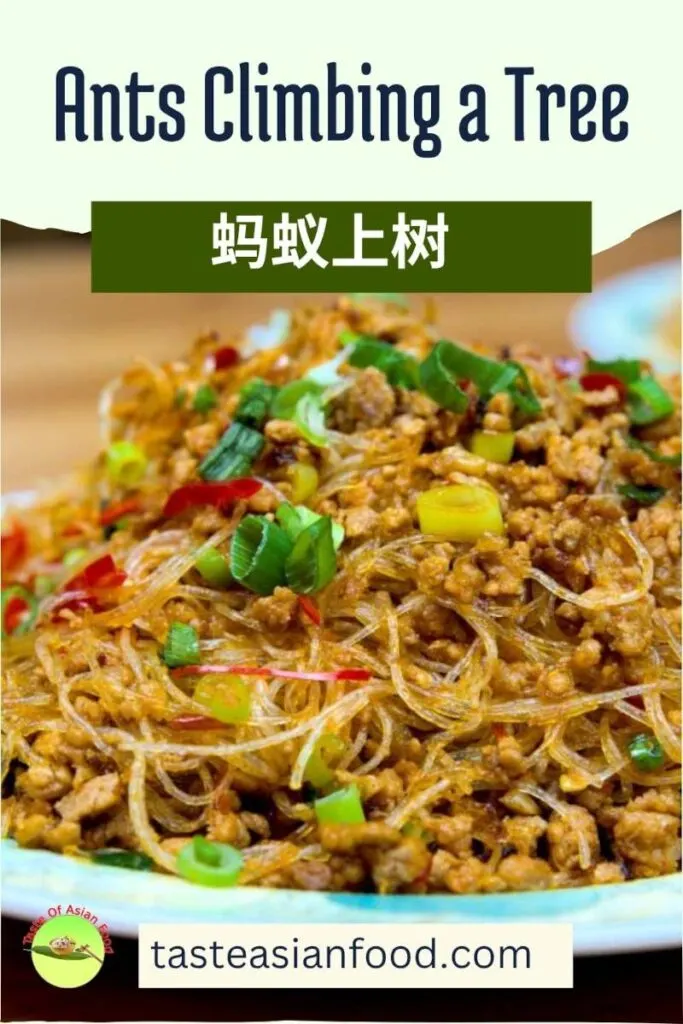
I’m going to do a split test to try both methods and see which one works better. In the meantime, let’s take a look at the main ingredients needed.
The Main Ingredient Required for This Recipe
- Glass noodles (Also called bean thread noodles, cellophane noodles, mung bean noodles, ma yi shang shu, 蚂蚁上树) are the key ingredient in this dish. I prefer to use glass noodles made from 100% mung bean starch. Some chefs, however, opt for noodles made from red potato starch. Glass noodles made with mung beans are white, while those made from red potato starch have a slightly reddish or brownish hue. These noodles have a very slippery, springy texture, which is the main characteristic of this dish.
- The second main ingredient in this recipe is minced pork, which is used almost every time this dish is made. However, if you don’t eat pork, you can substitute it with minced chicken or beef. The only downside to using chicken is that it’s much leaner and contains less fat compared to pork, which can result in a drier, less tender texture. For this reason, pork with a certain amount of fat (typically about one-quarter to one-third) is preferred. Cuts like pork loin or pork belly are usually the best choices for achieving the ideal balance of flavor and juiciness.
- The key seasoning for this dish is chili bean paste (toban djan, doubanjiang, 豆瓣酱), a staple in almost every Sichuan recipe. In addition to that, you’ll need some light soy sauce, dark soy sauce, sugar, and salt to balance the flavors. Another ingredient is Sichuan peppercorns, which add a slightly numbing sensation to the tongue. The peppercorns are optional, especially since some chili bean pastes already include Sichuan peppercorns as part of the blend.
- For the other supporting ingredients, you’ll need minced ginger, minced garlic, and chopped red chilies. I also prepared some extra chopped scallions (green onion) to use as a garnish just before serving.
Step-by-Step: How to Make Ants Climbing a Tree
- Soak the glass noodles in cold water in a large bowl for 30 minutes, or until they are fully softened and rehydrated. This step is important because if not, the noodles will be too hard after stir-frying, especially if using the method without adding more water.
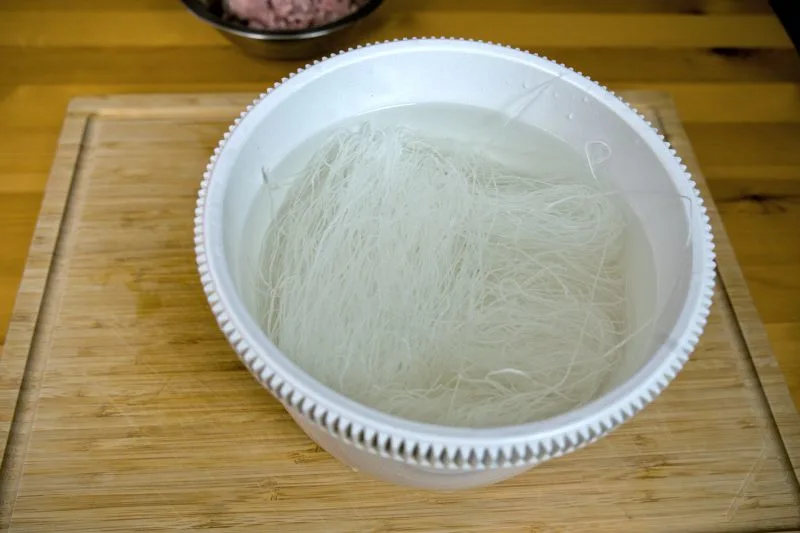
- Once the noodles have softened, set the drained noodles aside.
- If you buy ground meat from your butcher, I suggest mincing it once more at home before using it. This makes it much easier for the pork to cling to the glass noodles during cooking.
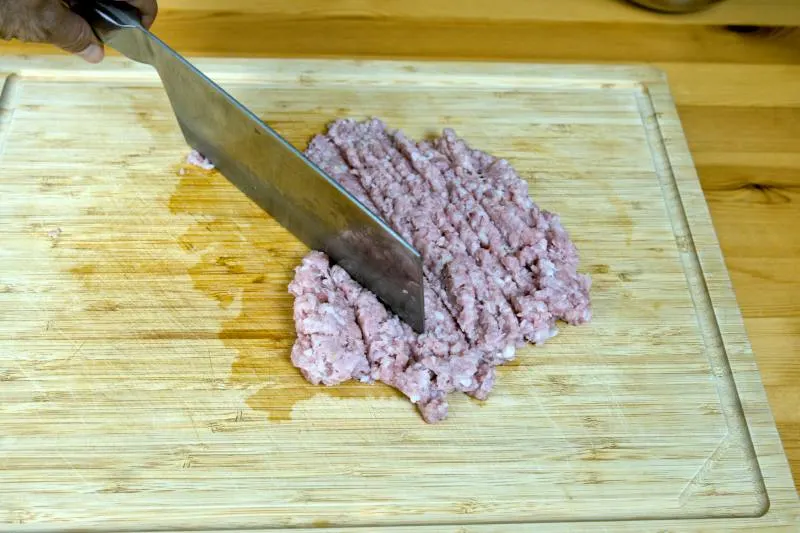
- Next, add some vegetable oil to a nonstick pan or a well-seasoned cast-iron wok and dry-fry the minced pork. There’s no need to season it at this stage, as we will add the seasonings later. I prefer to stir-fry it over low to medium heat until the pork becomes dry, slightly crispy, and lightly charred on the surface, which will take 5-6 minutes. This method helps bring out the best flavor.
- Add the chopped ginger and garlic to the pan halfway way stir-frying the pork. By this time, the fat should have rendered from the pork, so there’s no need to add extra oil to sauté the aromatics.
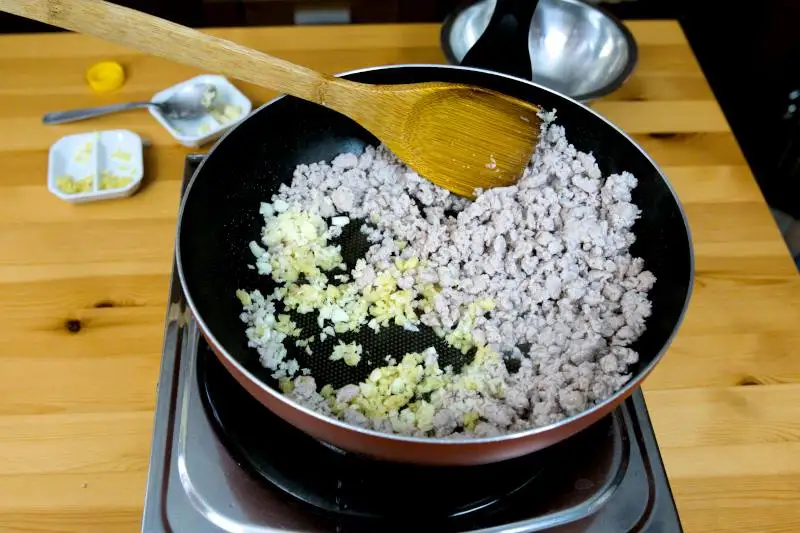
- At this point, add the chili bean paste and stir-fry until it becomes aromatic. Then, add light soy sauce, dark soy sauce, sugar, and salt to season the mixture.
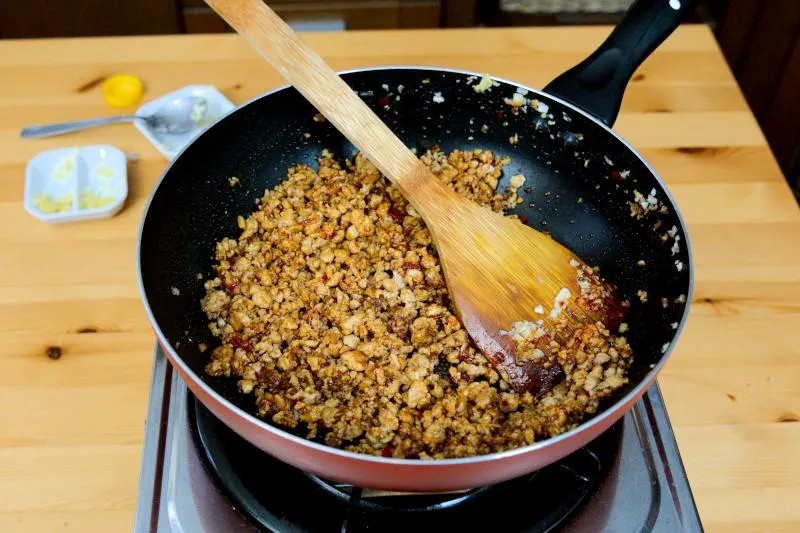
From this point, there are two ways to continue cooking the dish:
- The first method is to cook over lower heat. Add a few tablespoons of water to the sauce, then add the glass noodles and stir-fry until the noodles absorb all the liquid. This method works best if you don’t have a high-powered stove and need to cook the glass noodles a bit longer. Adding water helps prevent them from drying out or sticking.
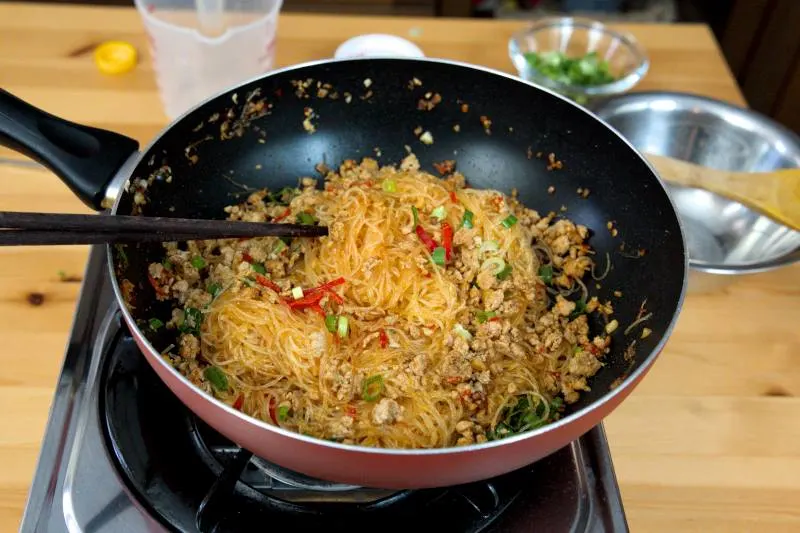
- The second method is ideal if you have a high-powered stove. Stir-fry the glass noodles together with the sauce over medium-high heat. This allows for a much shorter cooking time, and you won’t need to add any water. However, for this method to work well, you’ll need not only high heat but also a well-seasoned wok to prevent the noodles from sticking to the pan. I also suggest soaking the glass noodles a bit longer if you use this method, to ensure the final dish doesn’t turn out too dry.
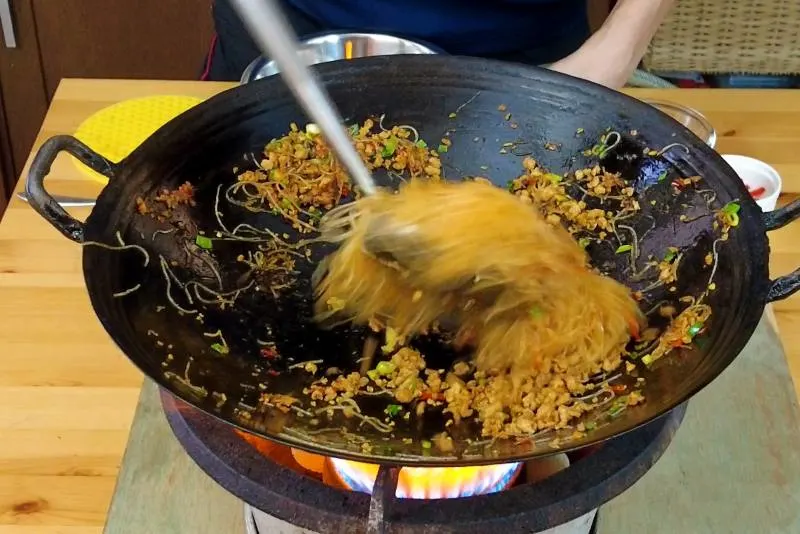
- Whichever method you choose, the final step is to add the chopped scallions and red chilies and mix them in thoroughly.
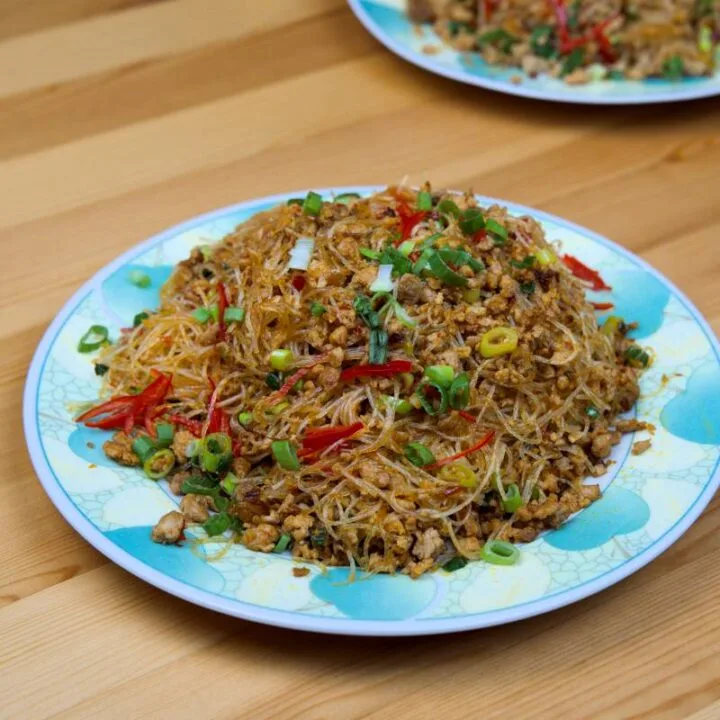
Ants Climbing a Tree (Glass Noodles & Minced Pork Stir-fry)
Find out how to cook Ants Climbing a Tree, a Sichuan noodle dish with minced pork. Includes ingredient tips and two ways to stir-fry.
Ingredients
Ingredients A
- 120g minced pork
- 100g glass noodles (dry weight)
- 1 tbsp chopped ginger
- 1 tbsp chopped garlic
- 1 red chili, cut into thin strips
- 2 stalks scallions, cut into thin sections
- 2 tbsp vegetable oil
Ingredients B
- 1.5 tbsp chili bean paste
- 1 tbsp light soy sauce
- 2 tsp dark soy sauce
- 1 tsp sugar
- 1 tsp salt
Instructions
- Soak the glass noodles in cold water for 30 minutes, or until they are fully softened and rehydrated. Once the noodles have softened, set the drained noodles aside.
- Mince the ground pork finely.
- Fry the minced pork with oil over low to medium heat until the pork becomes dry, slightly crispy, and lightly charred on the surface, which will take 5-6 minutes. Add the chopped ginger and garlic to the pan halfway way stir-frying the pork.
- Add the chili bean paste and stir-fry until it becomes aromatic. Then, add light soy sauce, dark soy sauce, sugar, and salt to season the mixture.
- From this point, there are two ways to continue cooking the dish:
- The first method is to cook over lower heat. Add a few tablespoons of water to the sauce, then add the glass noodles and stir-fry until the noodles absorb all the liquid.
- The second method is ideal if you have a high-powered stove. Stir-fry the glass noodles together with the sauce over medium-high heat. This allows for a much shorter cooking time, and you won’t need to add any water.
- Whichever method you choose, the final step is to add the chopped scallions and red chilies and mix them in thoroughly.
Recommended Products
As an Amazon Associate and member of other affiliate programs, I earn from qualifying purchases.
Nutrition Information:
Yield: 2 Serving Size: 1Amount Per Serving: Calories: 392Total Fat: 23gSaturated Fat: 5gTrans Fat: 0gUnsaturated Fat: 16gCholesterol: 53mgSodium: 2125mgCarbohydrates: 25gFiber: 2gSugar: 5gProtein: 21g
This data was provided and calculated by Nutritionix on 7/22/2025
Which is the better method?
The answer depends on whether you have a high-powered stove. Stir-frying without adding water produces a more flavorful result. However, this method requires a few things: a high-powered stove and a well-seasoned, non-stick cast-iron wok. With these in place, you can stir-fry quickly at high heat, creating a wonderful wok hei (wok aroma) and even a slight char on the surface of the noodles. The result is noodles that are drier, springier, and more aromatic.
If you don’t have a high-powered stove, it’s best to add a bit of water while stir-frying to prevent the noodles from sticking to the pan. The outcome is still delicious, though the noodles will be slightly softer and less springy compared to the high-heat version.

More Sichuan Favorites to Try After Ants Climbing a Tree
If you enjoy this Ants Climbing a Tree recipe, here are a few more related Sichuan dishes on this blog that you might want to try:
- Cabbage and Glass Noodle Stir-Fry – Another delicious way to use glass noodles, this dish is full of flavor but less spicy.
- Sichuan Boiled Beef – A classic Sichuan favorite you may have had at a restaurant. Follow this recipe to recreate it at home.
- Sichuan-Style Wontons – A distinct variation from the Cantonese version. It is spicy, savory, and worth trying if you enjoy bold flavors.



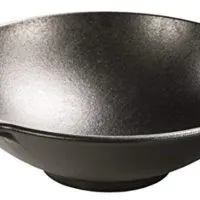
Osmanthus Eggs with Crab Meat: A Classic Stir-Fry (Kwai Fa Chi)
Thursday 31st of July 2025
[…] Ants Climbing a Tree. This is a classic stir-fried glass noodle dish made with minced meat. Its playful name comes from the way the glass noodles resemble tree branches, while the tiny bits of minced meat look like ants crawling along them. […]
Paul Ingham
Thursday 17th of March 2022
This version gives an authentic tasting recipe, absolutely delicious, we make it most weeks and love it. Thanks for posting such a great version.
KP Kwan
Friday 18th of March 2022
Thank you, Paul, and great to know that you love it.
Honor B Gosch
Thursday 2nd of April 2020
So yum! Thank you for posting such detailed instructions for each recipe. I was able to make this during the COVID quarantine in Los Angeles, although I didn't have the Szechuan chili oil. I'm looking forward to trying out a lot of your recipes and I hope that you and your family/loved ones are staying safe during this time.
KP Kwan
Thursday 2nd of April 2020
Thank you for trying my recipe. Fully understand, you may not be able to get everything in the recipe at this time. Just get the best out of it. Take care. We are lockdown in Kuala Lumpur too.
Paula Lye
Saturday 29th of February 2020
One of my favorite dishes. My mother's family was from Kwangchow....moved to British Guiana back in the day and I'm 4th generation. We ate this growing up and I still cook it, minus the sichuan bean paste and chili oil...both interesting additions which I shall try. We simply know it as "Funcee with pork" but I love the name "Ants climbing a Tree" Lovely to see you take an old tradional cantonese dish and give it new life with some Sichuan spice. Good for you!
KP Kwan
Sunday 1st of March 2020
Hi Paula, Great to know that you still carry on cooking the traditional cuisine pass down from your mother until today. Enjoy! KP Kwan
KP Kwan
Friday 28th of February 2020
Hi, this is KP Kwan. I am happy to see you in this comment area, as you have read through my recipe. I am pleased to reply to any questions and comments as soon as possible.